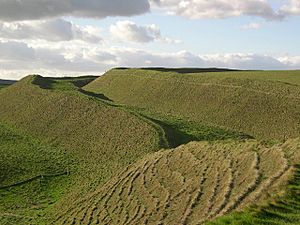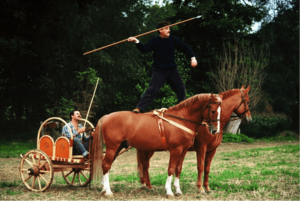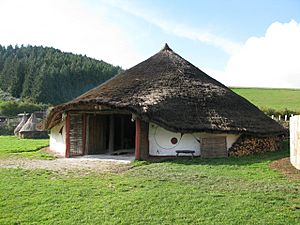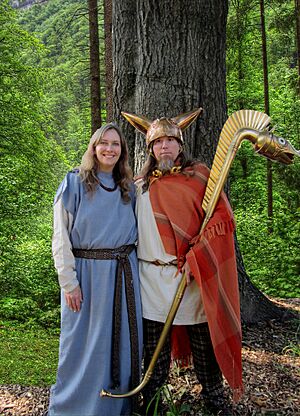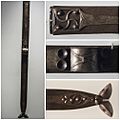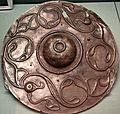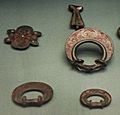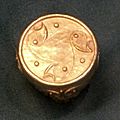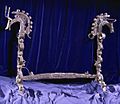British Iron Age facts for kids
| Geographical range | British Isles |
|---|---|
| Period | Iron Age, Hallstatt culture, La Tène culture |
| Dates | c. 800 BC—43 AD |
| Preceded by | Bronze Age Britain, Atlantic Bronze Age, Urnfield culture |
| Followed by | Roman Empire, Roman Britain |
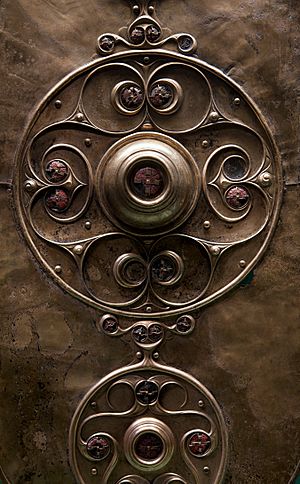
The British Iron Age is a period in history when people in Great Britain started using iron to make tools and weapons. This time came after the Bronze Age. It lasted from about 800 BC until 43 AD, when the Roman Empire began to take over the southern part of the island.
During this time, people in Britain are often thought of as being part of a larger "Celtic" culture. However, experts now mostly agree that "Celtic" mainly refers to the languages spoken, like Brittonic languages. It doesn't mean everyone shared the exact same way of life across all Celtic-speaking areas.
Contents
When Was the Iron Age in Britain?
How Do We Know the Dates?
Archaeologists have found over 100 large Iron Age sites in Britain. They use methods like radiocarbon dating to find out how old things are. This helps them create a timeline for the Iron Age.
The Iron Age in Britain didn't start at the same time as in other parts of Europe. British items often adopted Continental styles, like the La Tène style of Celtic art, much later.
| Period | Dates | What was happening in Europe |
|---|---|---|
| Earliest Iron Age | 800–600 BC | Hallstatt C |
| Early Iron Age | 600–400 BC | Hallstatt D and part of La Tène I |
| Middle Iron Age | 400–100 BC | The rest of La Tène I, all of II and part of III |
| Late Iron Age | 100–50 BC | The rest of La Tène III |
| Latest Iron Age | 50 BC – AD 100 |
|
Changes Over Time
In the "Late Iron Age," new types of pottery appeared. These might have been influenced by Roman or French cultures. People also started clearing more forests to grow crops, especially in areas with heavier, wetter soil. A type of grain called Spelt was grown in these new farming areas.
The Iron Age officially ended when the Romans arrived and started changing British culture. In parts of Britain not taken over by the Romans, like Scotland, the Iron Age continued a bit longer, perhaps until the 5th century AD.
What Did Iron Age Britain Look Like?
Farming and Land Use
During the late Bronze Age, people started using land differently. They created large field systems for farming. Settlements became more permanent, focusing on making the most of the land. Instead of building huge ceremonial sites like Stonehenge, people focused on farming and community.
Long ditches, sometimes miles long, were dug with enclosures at their ends. These likely marked land borders and showed a desire to control larger areas.
Connections with Europe
By 800 BC, Great Britain became more connected to Continental Europe, especially the south and east. New types of weapons, like the Carp's tongue sword, appeared. These were similar to those found on the Continent.
Phoenician traders might have visited Britain looking for minerals. They brought goods from the Mediterranean Sea. At the same time, many items from Northern Europe arrived in Eastern Britain across the North Sea.
Hill Forts and Brochs
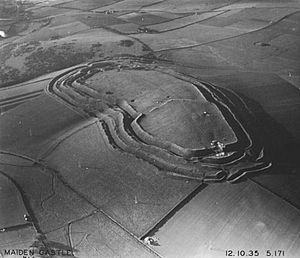
Many impressive defensive structures were built during this time. These include the brochs in Northern Scotland and hill forts across the rest of the islands. Famous hill forts include Maiden Castle, Dorset; Cadbury Castle, Somerset; and Danebury, Hampshire.
Hill forts first appeared in Wessex in the Late Bronze Age. They became common between 550 and 400 BC. The earliest ones were simple, with one wall. Many were connected to earlier ditch systems.
While called "forts," they were also used for daily life. Archaeologists have found evidence of food storage, workshops, and homes inside them. However, some hill forts might have been used only sometimes, not as permanent homes. Many show little sign of people living there all the time.
The building of hill forts might mean there was more tension between groups of people. Or, they could show that people were becoming wealthier and had a higher standard of living. They might have also been used as places for markets and social gatherings.
When the Romans invaded, these forts were not very effective against their attacks. Some hill forts continued to be used as settlements by the conquered Britons. Some were even reused by later groups, like the Anglo-Saxons.
Who Lived in Iron Age Britain?
Where Did People Come From?
The Roman historian Tacitus thought that the Britons came from people who had moved from Europe. He compared people in Scotland to Germanic groups and people in Wales to Spanish settlers. For a long time, people believed that new groups of invaders caused the changes seen in British culture.
However, by the 1960s, many experts thought that ideas and culture spread more slowly, rather than through big invasions. Today, it's understood that there were certainly large movements of people from Central Europe westwards during the early Iron Age. Whether these were "invasions" or "migrations" is a matter of how you describe them.
For example, the Belgae people arrived in Southern Britain from the end of the 2nd century BC. This was described by Julius Caesar. Regardless of how people arrived, it's clear that Britain had strong connections with Europe during the Iron Age.
How Many People Lived There?
Estimates suggest that by the 1st century BC, there could have been three or four million people in Iron Age Great Britain. Most lived in the fertile farming lands of the South. A high population density might have led to more tensions.
The average life expectancy was around 25 years old at birth. If someone lived to age five, they might live to about 30. Women often had a slightly lower life expectancy due to the dangers of childbirth.
Early in the Iron Age, pottery styles in Southern Britain suggest that people in that region were quite connected. But by 600 BC, different groups with their own pottery styles emerged. Between 400 and 100 BC, there was a big increase in population and people started to develop stronger regional identities.
Ptolemy's Description of Britain
Claudius Ptolemy described Britain at the start of Roman rule. He used the older name "Albion" for Britain. Other writers like Strabo and Pliny used "Britannia". Ptolemy's writings give us many details about the tribes and places in Britain at that time.
What Did Iron Age Britons Believe?
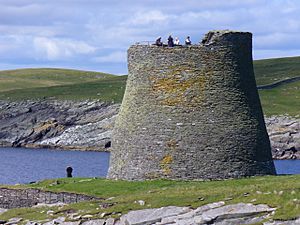
The Romans wrote about the many gods and goddesses worshipped in Northwestern Europe. Some gods were linked to men, the sky, and specific tribes. Goddesses were often linked to fertility, the earth, and were worshipped more widely. For example, the goddess Sulis was worshipped at Bath, often linked to wells and springs.
Religious practices often involved sacrificing animals or placing valuable metal items, especially war treasures, into the ground or water. Weapons and horse gear have been found in places like Llyn Cerrig Bach in Anglesey, believed to be gifts to the gods. Many weapons have also been found in rivers like the Thames. Some buried collections of jewelry are thought to be gifts to earth gods.
Archaeologists have also found special items placed in old grain storage pits and ditches. These include the bones of horses, dogs, and ravens, which seem to have been placed there on purpose.
Druids
Julius Caesar wrote that the priests in Britain were Druids. These were powerful religious leaders who also had a lot of influence in society. Britain seems to have been a very important place for the Druid religion. The Roman attack on Anglesey, led by Suetonius Paulinus, gives us some clues about their practices.
No direct archaeological evidence of Druids has been found. However, some burials in Kent with special items might suggest a religious role for the people buried there.
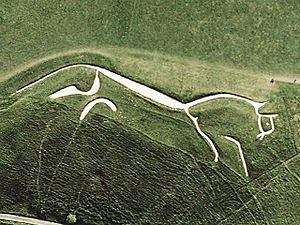
Places of Worship
Traditionally, people thought that Iron Age religion was practiced outdoors in natural places. However, archaeologists have found several sites that seem to be purpose-built shrines. Examples include sites at Hayling Island in Hampshire and one found near Heathrow Airport.
The Hayling Island site was a round wooden building inside a rectangular area. It was later rebuilt in stone by the Romans, following the same design. The Heathrow site was a small room surrounded by a ring of posts, similar to Roman-Celtic temples found elsewhere.
Other possible shrines have been found at Danebury and Cadbury Castle. These sites often include animal burials and metalwork. An open-air shrine was found at Hallaton, Leicestershire, where a large collection of coins and other objects, known as the Hallaton Treasure, was buried in a ditch.
Burial Practices
How people dealt with the dead varied across Iron Age Britain. Cremation (burning the body) was common. However, some areas had different practices. For example, the Arras culture in East Yorkshire had chariot burials, and Cornwall had cist burials (bodies placed in stone boxes). In Dorset, the Durotriges tribe had small cemeteries where bodies were buried, sometimes with valuable items.
It's hard to draw strong conclusions because not many Iron Age burials have been found. Some experts think that bodies might have been left out in the open to decay naturally, or that their remains were scattered.
How Did Iron Age Britons Live?
Trade and Craftsmanship
Britain had trade links with Europe even before the Iron Age. Many items from Europe, especially swords, were imported. British craftspeople often copied and even improved upon these designs. Early on, swords and daggers from the Hallstatt culture were important imports. Later, items from the La Tène culture (often linked to the Celts) were also adopted.
There was also a big change from using bronze to using iron. This might have happened because the supply of bronze decreased, making iron more important.
Animals and Farming
Cattle were very important in pre-Roman Britain. They were a source of wealth and provided milk, cheese, and leather. Later in the Iron Age, there seems to have been a shift towards raising more sheep. Sheep require less work per animal than cattle.
While cattle and sheep were most common, evidence of pigs, oxen, dogs, and sometimes chickens has also been found. Interestingly, there is little evidence of hunting wild animals or fishing, even in communities near the coast.
Salt and Coins
A key product in the Iron Age was salt, used for preserving food and adding to diets. Archaeologists have found evidence of Salterns, places where seawater was boiled to produce salt, especially in the East Anglia fenlands. Salt trading networks could span over 75 kilometers.
Iron Age coins are very important for understanding the economy. Some gold coins, called staters, were imported from Europe. Others, like the bronze coins of Southeast England, were influenced by Roman coins. British tribal kings also started putting their names on coins, like Tasciovanus and Cunobelinos.
Large collections of coins, called hoards, have been found. The Hallaton Treasure found in Leicestershire included over 5,000 coins, mostly from the Corieltavi tribe. These were buried in 14 separate hoards over many years.
The growth of the economy, especially in the later Iron Age, shows how social and economic status changed during this period.
Trade with Europe
Early and Middle Iron Age Trade

In the Early Iron Age, many goods from the Hallstatt culture were brought from Europe. These imports had a big impact on British art in the Middle Iron Age.
Late Iron Age Trade
From the late 2nd century BC onwards, South-Central Britain traded indirectly with Roman networks. This happened through Brittany and the Atlantic sea routes to southwestern Gaul. Hengistbury Head in Dorset was a major trading spot, where many Italian wine jars (amphorae) have been found. This Atlantic trade was disrupted after Julius Caesar's failed conquest of Brittany.
In Southeastern Britain, there was a lot of contact with the "Belgic" tribes of northern Gaul. Many imported Gallo-Belgic gold coins have been found there. These coins might not have just been for trade. Some experts think they were payments from Gaulish groups to their British allies for help against the Romans.
After Caesar conquered Gaul, trade between Southeastern Britain and nearby Europe really grew. This is shown by imports of wine, olive oil, and Roman pottery. Strabo, a writer from the 1st century AD, listed items imported to Britain, such as ivory chains, amber gems, and glass vessels. He said Britain exported grain, cattle, gold, silver, iron, animal hides, slaves, and hunting dogs. This trade likely grew because of political connections between British groups and the Roman world.
When Did the Iron Age End in Britain?
Historically, the Iron Age in Southern Great Britain ended with the Roman invasion in 43 AD. Even though British culture didn't change overnight, archaeologists see quick changes. For example, a Roman-Celtic shrine was built in Hayling Island, Hampshire, in the AD 60s or 70s, on top of an old Iron Age religious site.
New rectangular stone buildings, showing a shift to the Roman style of housing, appeared from the mid-to-late 1st century AD.
In areas where Roman rule wasn't strong or didn't exist, Iron Age beliefs and practices continued. However, they still had some influence from the Romans. The survival of place names like Camulodunum (Colchester), which come from the native language, shows this mix of cultures.
See also
| Iron Age |
|---|
| ↑ Bronze Age |
|
Ancient Near East (1200–550 BC)
South Asia (1200–200 BC) East Asia (500 BC – 300 AD) Iron metallurgy in Africa |
|
Iron Age metallurgy |
↓ Ancient history
|
Historiography
|
Images for kids
-
Tre'r Ceiri hillfort remains, Wales
-
Crannog reconstruction, Scotland
-
Remains of fortifications at the Stanwick hillfort
-
Broch of Dun Troddan, Scotland, internal stairs
-
Old Oswestry hillfort remains, England
-
Reconstruction of a gate at Cadbury Castle hillfort, England


